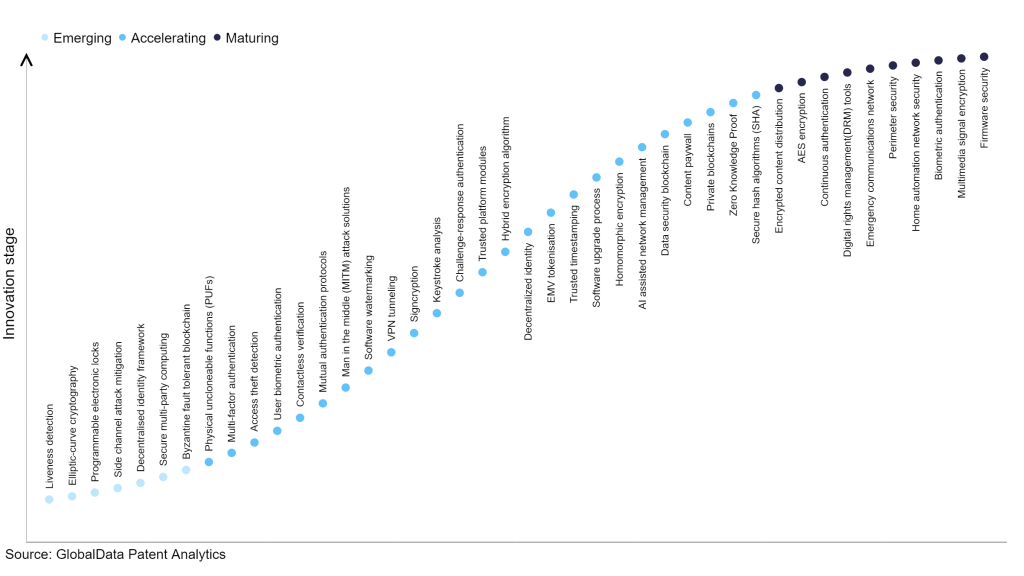The technology industry continues to be a hotbed of innovation, with activity driven by the rising instances of firmware attacks, the rapid growth of IoT devices, increased reliance on embedded systems, and the need for data integrity and privacy, as well as growing importance of technologies such as intrusion detection systems (IDS), intrusion prevention systems, firmware analysis tools and vulnerability management systems. Firmware security uses code signing that involves digitally signing firmware or software components with a cryptographic key to ensure that firmware updates or patches come from trusted sources and have not been tampered with. In the last three years alone, there have been over 3.6 million patents filed and granted in the technology industry, according to GlobalData’s report on Innovation in Cybersecurity: Firmware security. Buy the report here.
However, not all innovations are equal and nor do they follow a constant upward trend. Instead, their evolution takes the form of an S-shaped curve that reflects their typical lifecycle from early emergence to accelerating adoption, before finally stabilising and reaching maturity.
Identifying where a particular innovation is on this journey, especially those that are in the emerging and accelerating stages, is essential for understanding their current level of adoption and the likely future trajectory and impact they will have.
300+ innovations will shape the technology industry
According to GlobalData’s Technology Foresights, which plots the S-curve for the technology industry using innovation intensity models built on over 2.5 million patents, there are 300+ innovation areas that will shape the future of the industry.
Within the emerging innovation stage, byzantine fault tolerant blockchain, secure multi-party computing and decentralized identity framework are disruptive technologies that are in the early stages of application and should be tracked closely. Secure hash algorithms (SHA), zero knowledge proof, and private blockchains are some of the accelerating innovation areas, where adoption has been steadily increasing. Among maturing innovation areas are firmware security and multimedia signal encryption, which are now well established in the industry.
Innovation S-curve for cybersecurity in the technology industry

Firmware security is a key innovation area in cybersecurity
Firmware security involves safeguarding the firmware installed on a device, aiming to prevent unauthorised access and malicious code. Its purpose is to hinder attackers from exploiting firmware vulnerabilities, which could compromise sensitive data or enable unauthorised control over the device. To achieve this, firmware security relies on authentication, encryption, code signing, and various other security mechanisms.
GlobalData’s analysis also uncovers the companies at the forefront of each innovation area and assesses the potential reach and impact of their patenting activity across different applications and geographies. According to GlobalData, there are 40+ companies, spanning technology vendors, established technology companies, and up-and-coming start-ups engaged in the development and application of firmware security.
Key players in firmware security – a disruptive innovation in the technology industry
‘Application diversity’ measures the number of different applications identified for each relevant patent and broadly splits companies into either ‘niche’ or ‘diversified’ innovators.
‘Geographic reach’ refers to the number of different countries each relevant patent is registered in and reflects the breadth of geographic application intended, ranging from ‘global’ to ‘local’.
Patent volumes related to firmware security
Source: GlobalData Patent Analytics
Intel is a leading patent filer in firmware security. The company’s patents are aimed at invention describing techniques for control flow protection with minimal performance overhead. It involves utilising one or more micro-architectural optimisations to implement a shadow stack (SS) to verify a return address before returning from a function call, for instance in a computing platform, such as an IoT platform, that overlaps or parallelises one or more SS access operations with one or more data stack (DS) access operations.
Other prominent patent filers in the space include Dell Technologies and Apple.
By geographic reach, Pendrell leads the pack, followed by Microsoft and Vodafone Group. In terms of application diversity, Alphabet holds the top position, followed by Vodafone Group and Microsoft.
Firmware security helps in protecting devices from unauthorised access and malicious code, safeguarding sensitive data and ensuring the integrity of embedded systems. By implementing robust firmware security measures, organisations can mitigate risks, maintain trust in their products, and uphold the confidentiality and functionality of firmware-based devices.
To further understand how cybersecurity is disrupting the technology industry, access GlobalData’s latest thematic research report on Cybersecurity – Thematic Research.
Data Insights
From

The gold standard of business intelligence.
Blending expert knowledge with cutting-edge technology, GlobalData’s unrivalled proprietary data will enable you to decode what’s happening in your market. You can make better informed decisions and gain a future-proof advantage over your competitors.







